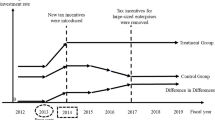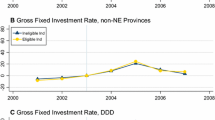Abstract
We studied the effect of tax policy on the productivity of Taiwanese manufacturing firms from 2001 to 2008. First, we investigated the determinants of firm decisions on tax credit applications. By employing the dynamic random effect probit model, this study demonstrated that past tax credit use has exerted a causal effect on current tax credit use across various industries. Specifically, there has been a persistence use of tax credit among manufacturing firms in Taiwan. Second, we employed the panel instrumental variable approach to control for tax credit endogeneity and firm heterogeneity in determining firm productivity. The results indicated that firms’ tax credit use produced a positive and statistically significant effect on productivity. Finally, after categorising the firms as either electronics or non-electronics businesses, we observed that the marginal effect of tax credits has been associated with the productivity of electronics firms. This study demonstrated that tax credit use among Taiwanese firms has enhanced their productivity. This indicates that effective tax policy can promote national economic growth.
Similar content being viewed by others
Notes
Girma et al. (2007b) provides a comprehensive literature review.
Klette et al. (2000) provides a detailed discussion on the advantages and disadvantages of both tax incentives and direct subsidies.
Özçelik and Taymaz (2008) describe a comprehensive survey of direct subsidies related to R&D activities.
Czarnitzki et al. (2011) provides further details on innovation-related R&D tax credits.
Before 1991, Taiwan’s primary industrial technology policy was the Statute for the Encouragement of Investment.
Under the SUI regulations, a firm can credit 35 % of the funds invested in R&D and personnel training against the amount of profit-seeking enterprise income tax payable each year, within 5 years prior to the current year.
In Sect. 3, given the need to estimate a dynamic specification with lagged endogenous variables, we compiled a balanced panel data. We excluded firms that have experienced a substantial increase in turnover because of merges during the analysis period. The observations for 2001 were used as regressors, representing the initial condition, and the remaining observations from 2002 to 2008 were included in the regression. After the cleaning procedure was performed, the total number of firms remaining for empirical analysis was an 8-year panel of 508 firms, containing 3,556 observations.
The TEJ is a reputable commercial company that collects and summarises information for companies listed on the TSE. The TEJ databank is reliable and widely adopted by the majority of universities in Taiwan and various firms in the financial sector. This databank contains comprehensive information, including balance sheets, financial statements, and annual reports.
Details on the construction of the TFP index are included in the “Appendix”.
To save space, the estimates for the time-average of explanatory variables are not shown in Table 4. This is also because the estimated coefficients do not provide any meaningful economic implications.
To conserve space, we omitted the test results regarding endogeneity between lnTAXC and lnTFP. These results are available upon request.
They used capital subsidies as the proxy variable for policy tools.
References
Archibald, R. B., & Pereira, A. M. (2003). Effects of public and private R&D on private-sector performance in the United States. Public Finance Review, 31(4), 429–451.
Arrow, K. J. (1962). Economic welfare and the allocation of resources for inventions. In R. R. Nelson (Ed.), The rate and direction of inventive activity: economic and social factors. Princeton: Princeton University Press.
Bernard, A., Redding, S., & Schott, P. (2010). Multiple-product firms and product switching. American Economic Review, 100(1), 70–97.
Bloom, N., Griffith, R., & Van Reenen, J. (2002). Do R&D tax credits work? Evidence from a panel of countries 1979-1997. Journal of Public Economics, 85(1), 1–31.
Czarnitzki, D., Hanel, P., & Rosa, J. M. (2011). Evaluating the impact of R&D tax credits on innovation: A microeconometric study on Canadian firms. Research Policy, 40(2), 217–229.
Ericson, R., & Pakes, A. (1995). Markov-perfect industry dynamics: A framework for empirical work. Review of Economic Studies, 62(1), 53–82.
Geroski, P. A., & Jaquemin, A. (1998). The persistence of profits: A European comparison. Economic Journal, 98(391), 375–389.
Girma, S., Görg, H., & Strobl, E. (2007a). The effect of government grants on plant survival: A micro-econometric analysis. International Journal of Industrial Organization, 25(4), 701–720.
Girma, S., Görg, H., & Strobl, E. (2007b). The effect of government grants on plant level productivity. Economics Letters, 94(3), 439–444.
Goel, R. K., Payne, J. E., & Ram, R. (2008). R&D expenditures and U.S. economic growth: A disaggregated approach. Journal of Policy Modeling, 30(2), 237–250.
Griffith, R., Redding, S., & Reenen, J. V. (2004). Mapping the two faces of R&D: Productivity growth in a panel of OECD industries. Review of Economics and Statistics, 86(4), 883–895.
Harris, R., & Robinson, C. (2004). Industrial policy in Great Britain and its effect on total factor productivity in manufacturing plants, 1990–1998. Scottish Journal of Political Economy, 51(4), 528–543.
Harris, R., & Trainor, M. (2005). Capital subsidies and their impact on total factor productivity: Firm-level evidence from Northern Ireland. Journal of Regional Science, 45(1), 49–74.
Klette, T., Møen, J., & Griliches, Z. (2000). Do subsidies to commercial R&D reduce market failures? Microeconomic evaluation studies. Research Policy, 29(4), 471–495.
Levinsohn, J., & Petrin, A. (2003). Estimating production functions using inputs to control for unobservables. Review of Economic Studies, 70(2), 317–341.
Lien, W. J., Wang, J. C., Wang, S. W., & Tsai, F. H. (2010). The economic impact of Taiwan’s investment tax credits and its direction of adjustment. International Journal of Technology Management, 49(1/2/3), 140–154.
Nelson, R. (1959). The simple economics of basic scientific research. Journal of Political Economy, 67(3), 297–306.
Olley, S. G., & Pakes, A. (1996). The dynamics of productivity in the telecommunications equipment industry. Econometrica, 64(6), 1263–1297.
Özçelik, E., & Taymaz, E. (2008). R&D support programs in developing countries: The Turkish Experience. Research Policy, 37(2), 258–275.
Parisi, M. L., Schiantarelli, F., & Sembenelli, A. (2006). Productivity, innovation and R&D: Micro evidence for Italy. European Economic Review, 50(8), 2037–2061.
Petrin, A., Poi, B. P., & Levinsohn, J. (2004). Production function estimation in Stata using inputs to control for unobservable. Stata Journal, 4(2), 113–123.
Staiger, D., & Stock, J. H. (1997). Instrumental variables regression with weak instruments. Econometrica, 65(3), 557–586.
Stoneman, P., & Diederen, P. (1994). Technology diffusion and public policy. Economic Journal, 104(425), 918–930.
Wooldridge, J. M. (2005). Simple solutions to the initial conditions problem in dynamic nonlinear panel data models with unobserved heterogeneity. Journal of Applied Econometrics, 20(1), 39–54.
Acknowledgments
Chia-Hui Huang is grateful to the National Science Council of Taiwan for financial support of this study (NSC 99-2410-H-156-008-). We would like to thank anonymous referees for their helpful comments. All remaining errors are our own.
Author information
Authors and Affiliations
Corresponding author
Appendix: Construction of total factor productivity
Appendix: Construction of total factor productivity
To determine whether tax policy and R&D activities are crucial to the productivity of Taiwan’s manufacturing industries, identifying an appropriate measure of productivity is necessary. The measure of productivity used in this paper is a semi-parametric approach that was initially recommended by Olley and Pakes (1996) and subsequently modified by Levinsohn and Petrin (2003). The primary advantage of the Levinsohn and Petrin (2003) method is that it controls for the endogeneity of input selection. Following the Levinsohn and Petrin (2003) technique, we estimated a log-linear transformation of the Cobb-Douglas production function, expressed as
where REV i,t is the logarithm of the revenue of firm i at time t; K i,t is the logarithm of the firm’s fixed assets; SKL i,t and NSKL i,t are the logarithms of skilled labour and non-skilled labour, respectively; and ELEC i,t is the logarithm of electricity.
According to the Levinsohn and Petrin (2003) method, we considered the problem of endogeneity between ɛ i,t and the regressors in Eq. (4) by determining ɛ i,t = ω i,t + η i,t , where ω i,t is the transmitted component; hence, this influences the firm’s decision rules, whereas η i,t is an i.i.d. component that does not affect the firm’s decisions. Therefore, Eq. (4) can be rewritten as
The demand function of intermediate input (ELEC) is given as
Levinsohn and Petrin (2003) demonstrated that this relationship is monotonically increasing in ω i,t ; therefore, the intermediate input function can be inverted to obtain ω i,t = ω i,t (K i,t , ELEC i,t ). The unobservable productivity term is then expressed solely as a function of the two observed inputs. Thus, the equation for the productivity function is expressed as
where \( \varphi (K_{i,t} ,ELEC_{i,t} ) = \beta_{0} + \beta_{1} K_{i,t} + \omega_{i,t} (K_{i,t} ,ELEC_{i,t} ) \).
Equation (7) can be estimated using the procedures discussed by Petrin et al. (2004). Therefore, the total factor productivity is defined as
Rights and permissions
About this article
Cite this article
Huang, CH. Tax credits and total factor productivity: firm-level evidence from Taiwan. J Technol Transf 40, 932–947 (2015). https://doi.org/10.1007/s10961-014-9358-7
Published:
Issue Date:
DOI: https://doi.org/10.1007/s10961-014-9358-7




